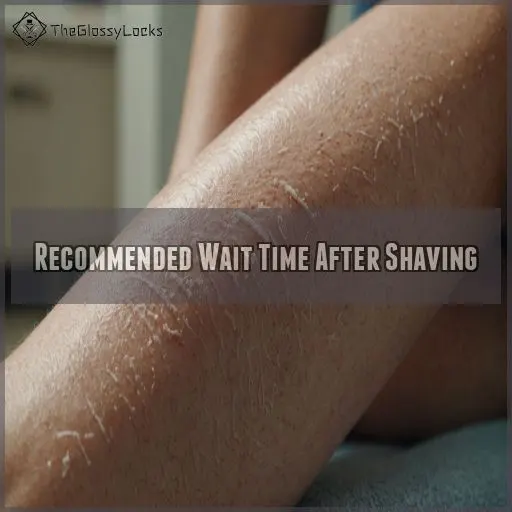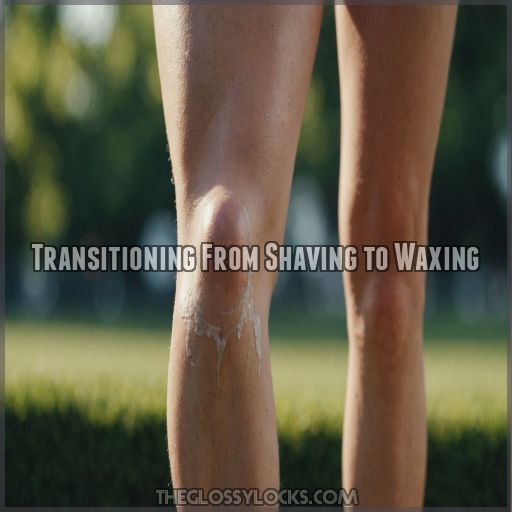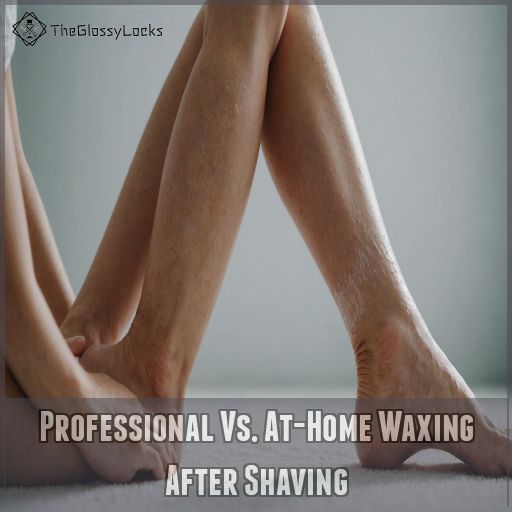This site is supported by our readers. We may earn a commission, at no cost to you, if you purchase through links.
 Wondering how long after shaving you can wax? It’s best to wait at least 2 to 3 weeks.
Wondering how long after shaving you can wax? It’s best to wait at least 2 to 3 weeks.
This gives your hair enough time to regrow to the sweet spot of about a quarter-inch long, important for the wax to grip effectively. Picture your hair as the rebellious teenager, needing time to gather its strength before facing the wax’s wrath!
This wait also allows your skin to recover from any razor-induced rebellion. Jumping the gun might lead to ingrown hairs or irritation, so patience is your secret weapon.
Stick around for more insider tips on mastering the art of waxing timing!
Table Of Contents
- Key Takeaways
- Optimal Hair Length for Effective Waxing
- Recommended Wait Time After Shaving
- Preparing Skin for Waxing Post-Shaving
- Hair Growth Cycles and Waxing Timing
- Transitioning From Shaving to Waxing
- Alternative Hair Removal Methods During Regrowth
- Professional Vs. At-Home Waxing After Shaving
- Long-Term Benefits of Waxing Over Shaving
- Frequently Asked Questions (FAQs)
- Can I get a Brazilian wax if I shaved 5 days ago?
- Can I wax 7 days after shaving?
- How long should you let your pubic hair grow before waxing?
- Is 2 weeks hair growth enough for waxing?
- What are the potential side effects of waxing after shaving?
- How can I minimize pain and discomfort during the waxing process?
- What are the best post-waxing care practices to prevent ingrown hairs?
- How does the frequency of waxing change over time compared to shaving?
- What are the long-term benefits of transitioning from shaving to waxing?
- Conclusion
Key Takeaways
- You’ll want to play the waiting game—aim for at least 2 to 3 weeks after shaving before you wax. Let your hair reach the sweet spot of about a quarter-inch, just long enough to give the wax something to grip. Think of it like trying to catch a baseball; both require the perfect timing and grip.
- Treat your skin right before waxing. Exfoliate gently, avoid harsh products, and keep your skin moisturized, just like pampering a classic car for a smooth ride. Skin care is essential, so your skin doesn’t throw a fit when it meets the wax.
- Understand that waiting longer helps you avoid pesky ingrown hairs and irritation. Patience is your silent superhero here; jumping too soon can lead to a face-off with painful, ineffective results, and nobody wants that.
- While you’re waiting for that perfect wax time, explore other options like trimming or using depilatory creams. They can help maintain the peace between hair-removal sessions without disrupting the all-important growth cycle.
Optimal Hair Length for Effective Waxing
If you’ve ever wondered how long to wait after shaving before you can wax, you’re not alone—many people are caught off guard by the timing!
For effective waxing, it’s best to let your hair grow to at least a quarter inch, which is just long enough to resemble a grain of rice, so put down the razor and let nature take its course.
Minimum Hair Growth Requirements
Before waxing, be sure your hair’s grown out—like grass after a spring rain—for at least four weeks since shaving! Hair regrowth takes patience. Aim for a quarter-inch patch, understanding it varies with hair texture and growth speed.
Ideal Hair Length for Different Body Areas
Ideal Hair Length for effective waxing is crucial, as hair needs to be a certain length for the wax to adhere properly. for effective waxing
Grabbing a ruler might not be necessary, but aim for around a quarter-inch of fluffy sherpa-like goodness for seamless waxing.
Hair Length Recommendations
Here’s the scoop for each area:
- Facial hair: 1/4 inch
- Underarms: 1/2 inch
- Intimate areas: 1/4 inch
- Legs: 1/4 inch
Impact of Hair Texture on Growth Time
Hair texture plays a big role in how quickly it grows back.
Coarse, thick hair may need 4-6 weeks before waxing, while fine, thin hair may only require 3-4 weeks.
Pay attention to your unique growth patterns for the best waxing results.
Measuring Hair Length Accurately
Measuring hair length accurately is like finding the sweet spot in Goldilocks’ porridge.
Use a ruler or growth chart to make sure hair is about a quarter-inch—ideal for the waxing process.
Consult your waxing therapist for visual guides and tailor your preparation accordingly.
Recommended Wait Time After Shaving
When you’re ready to switch from shaving to waxing, timing is everything to prevent unwanted ouch moments!
Wait at least two weeks after shaving to give your hair enough time to grow to the ideal length.
Minimum Wait Period for Pubic Hair
After achieving the right hair length for effective waxing, it’s recommended to wait at least four weeks post-shaving for pubic hair to remove wax with oil.
This allows proper growth and minimizes ingrown hair risks, which are a concern when shaving.
Embrace patience for smoother results and consult a waxing specialist for professional advice.
Wait Times for Legs, Arms, and Underarms
For your legs, arms, and underarms, aim to wait at least 3 weeks after shaving before waxing.
This gives the hair enough time to grow out for a smooth, comfortable wax.
Patience pays off!
Factors Affecting Hair Regrowth Speed
Regrowth speed is like a mischievous cat—it varies wildly! Hormonal changes, hair type, and age play critical roles. Medications and diet also impact this process. To maximize waxing benefits, consider these factors when planning your next appointment to avoid those ingrown hairs!
- Hormonal changes
- Hair type
- Medications
- Age, diet
Risks of Waxing Too Soon After Shaving
Ignite your inner control nut! Waxing too soon post-shave leads to ingrown hairs, skin irritation, and broken hairs.
The result? Increased waxing pain and uneven results. Avoid this pitfall for a smoother waxing experience, especially with a Brazilian wax at the salon.
Preparing Skin for Waxing Post-Shaving
You’re ready to embrace the wax life, but your skin needs a little TLC first. Let’s chat about keeping it smooth, happy, and eruption-free before the big day!
Exfoliation Techniques to Prevent Ingrown Hairs
Exfoliate regularly with gentle scrubs or chemical peels to slough off dead skin and prevent pesky ingrown hairs.
Avoid harsh exfoliants right before your wax – your skin needs to be prepped, not irritated.
- Soft washcloth
- Gentle body scrub
- Alpha hydroxy acids
- Beta hydroxy acids
Moisturizing Routines for Optimal Skin Condition
To make sure baby-soft skin post-wax, make moisturizing routines part of your daily drill.
Use light moisturizers for skin hydration and ingrown hair prevention.
You’ll be as smooth as silk in no time—ideal for your next waxing booking!
Avoiding Irritants and Harsh Products
Getting ready for a wax? Steer clear of products with harsh chemicals and heavy perfumes.
Gentle skincare is key! Sensitive skin benefits from mild ingredients, ensuring smoother waxing.
Think of it as avoiding a minefield—your skin will thank you for the peace!
Pre-wax Skin Treatments and Their Benefits
Getting ready for your first wax occasionally feels like an adventure, right?
Pre-wax treatments can make a world of difference:
- Exfoliation types: Slough off dead skin, reducing ingrown hair risk.
- Moisturizing routines: Hydrated skin grips wax better.
- Benefits of preparation: Enhances results, minimizes discomfort.
Hair Growth Cycles and Waxing Timing
Timing your waxing appointments just right is key for smooth, long-lasting results.
Understanding your hair growth cycles and how shaving affects them can help you schedule waxing sessions that maximize effectiveness.
Understanding the Anagen, Catagen, and Telogen Phases
Hair growth occurs in stages: the anagen (growth), catagen (transition), and telogen (rest) phases.
Like a three-act play, each has its role.
Understanding these phases helps you time your waxing for the best results, minimizing discomfort and maximizing smoothness.
| Phase | Duration | Function |
|---|---|---|
| Anagen | 2-7 years | Active growth |
| Catagen | 2-3 weeks | Regrowth stops |
| Telogen | 3-4 months | Rest and shed |
How Shaving Affects Hair Growth Cycles
Ever wonder why shaving so often trips up your hair growth cycle? It’s a bit like hitting the reset button too soon. Frequent shaving can:
- Disrupt hair cycles
- Damage follicles
- Increase ingrown hair risk
- Cause razor burn
Keep this in mind!
Timing Waxing Appointments for Maximum Effectiveness
You’ve mastered hair growth cycles for the best waxing frequency.
Aim to book every 4-6 weeks when hair is ripe for removal and skin’s ready.
Forget shaving’s pesky ingrown hairs; embrace waxing’s smoother sail and rediscover your skin’s texture!
Strategies for Synchronizing Hair Growth Cycles
If you’re stuck in the waxing cycle tango, try syncing hair growth phases with these steps:
- Schedule regular appointments every 4-6 weeks.
- Be patient with a gradual change.
- Trim between sessions to manage regrowth.
- Consider alternate hair removal methods.
Transitioning From Shaving to Waxing
Switching from shaving to waxing requires patience as you navigate stubble, thicker regrowth, and uneven hair lengths.
Embrace the challenge with expectations set for a smoother journey ahead, because perfection takes time and a bit of belief!
Gradual Transition Techniques for Sensitive Areas
Mastering waxing timing is an art!
For sensitive areas, patience and consistency are golden.
Begin with gentle exfoliation and a moisturizing routine.
Opt for careful hair trimming to avoid irritation.
Embrace your skin prep ritual—it keeps skin silky smooth and smiling!
Managing Stubble and Uneven Growth
Craving smooth skin during your journey? Managing stubble and uneven growth is a breeze by following these tips:
- Exfoliate regularly.
- Moisturize to minimize irritation.
- Use stubble grooming tips.
- Understand your hair growth cycle.
Managing stubble and uneven growth is a breeze by following these tips:
- Exfoliate regularly.
- Moisturize to minimize irritation.
- Use stubble grooming tips.
- Understand your hair growth cycle.
Exfoliate regularly to help remove dead skin cells and promote smoother skin.
Moisturize to minimize irritation and keep your skin hydrated.
Use stubble grooming tips to manage the appearance of stubble and uneven growth.
Understand your hair growth cycle to better manage your grooming routine.
Dealing With Thicker Regrowth After Shaving
After grappling with uneven stubble, waxers often face denser hair.
Handle it with care! Shaving vs. waxing changes hair cycles, leading to thicker regrowth.
Keep your chin up, exfoliate gently, and know you’ll soon savor smooth, fuzz-free freedom!
Patience and Expectations During the Transition Period
In this journey from stubble management to waxing smoothness, patience is your best friend.
Prepare for uneven growth and thicker regrowth initially.
Manage expectations; a gradual change works wonders.
Alternative Hair Removal Methods During Regrowth
While you wait for your hair to reach the right length for waxing, you don’t have to suffer through unsightly stubble.
Explore alternative hair removal methods like trimming, chemical depilatories, or discreet management techniques to keep things tidy until your next waxing appointment.
Temporary Solutions for In-between Stages
When you’re stuck in that hairy no man’s land, embrace shaving alternatives like depilatory creams to temporarily manage growth.
Though these at-home solutions won’t stop hair growth cycles, they’ll give you peace of mind until your next wax.
Keep calm and cream on!
Trimming Vs. Shaving While Waiting to Wax
Everyone’s been there: unsure whether to trim or shave while waiting to wax. Here’s the scoop:
- Trim to maintain hair length.
- Control irritation with moisturizer.
- Avoid shaving to prevent ingrown hairs and uneven regrowth.
Stay savvy and smooth!
Chemical Depilatories: Pros and Cons
Feeling like a hair-removal connoisseur? Chemical depilatories can be your go-to alternative. They’re quick and painless, yet skin irritation or odor might crop up.
Chemical depilatories offer a quick and painless hair removal method, but they are not as long-lasting as other methods like threading.
However, skin irritation and strong odor may occur.
| Pros | Cons | Considerations |
|---|---|---|
| Quick | Skin irritation potential | Patch test recommended |
| Painless | Strong odor | Well-ventilated area |
| Lasting effect | Not suitable for sensitive skin | Cost comparison needed |
Therefore, a patch test is recommended before full application.
A well-ventilated area is essential during use.
Sensitive skin may not tolerate chemical depilatories.
Cost comparison with other methods is advised.
Managing Visible Hair Growth in Public
Feeling self-conscious about visible stubble? No need to hide away!
Try wearing looser clothing or using a bit of makeup to camouflage any pesky regrowth until your next waxing appointment.
Own that confidence, babe!
Professional Vs. At-Home Waxing After Shaving
If you’ve just shaved and are wondering whether to try waxing professionally or at home, you’re not alone!
Professional waxing might save you from sticky disasters and give you a smooth finish,
but at-home attempts (armed with patience and the right wax) can become oddly satisfying DIY projects.
Benefits of Professional Waxing for Post-shave Regrowth
While DIY methods offer quick fixes, professional waxing gives you smooth, longer-lasting results with less irritation.
Skilled experts use techniques that minimize pain and avoid ingrown hairs.
Putting your skin in the hands of professionals means you can relax knowing it’s in good care, giving you peace of mind.
DIY Waxing Tips for Recently Shaved Areas
If you’re thinking about DIY waxing after shaving, give your skin some time.
At least four weeks makes for the best grip.
Keep exfoliating gently, and moisturize to dodge ingrown hairs.
Choose a quality at-home kit to minimize discomfort—practice makes perfect!
Choosing the Right Wax for Sensitive Skin
When waxing sensitive skin after shaving, opt for a gentle, hypoallergenic wax formulated with soothing ingredients like aloe vera.
Steer clear of harsh chemicals that could trigger irritation or allergic reactions.
Your comfort and safety are the top priorities.
Safety Precautions for At-home Waxing
Choosing the right wax is like picking a dance partner.
For sensitive skin, find a gentle formula to avoid burns.
Practice proper technique—always test wax temperature first!
Post-wax care is key; soothe your skin with an antiseptic moisturizer.
Enjoy!
Long-Term Benefits of Waxing Over Shaving
Switching from shaving to waxing has incredible perks: you’ll notice less hair and enjoy longer breaks between sessions.
Smoother skin with fewer bumps is another benefit, making it feel like a delightful spa treat!
Reduced Hair Thickness and Density Over Time
You’re saving the DIY waxing kit for later, huh? Wise choice!
With regular waxing, hair grows back finer and sparser, much like the long-term benefits of laser treatments, minus the hefty costs.
It’s the shaving-vs-waxing showdown, and waxing wins!
Extended Periods Between Hair Removal Sessions
Waxing offers longer stretches between hair removal sessions compared to shaving, but it’s crucial to wait for the wax to cool and harden before attempting removal.
You can expect to visit your waxer every 4-6 weeks.
Over time, your hair growth cycle will sync up, resulting in smoother, more manageable results.
Improved Skin Texture and Reduced Irritation
Your skin’s texture? Waxing can work wonders! Embrace fewer ingrown hairs and reduced irritation by ditching the razor.
Here’s what you’ll love:
- Smoother feel
- Gentler aftercare
- Less skin annoyances
- Long-term silky goodness
- Reduced skin sensitivity
Fantastic, right?
Cost Comparison of Waxing Vs. Regular Shaving
You’ve noticed waxing enhances skin texture.
Now, let’s talk cost: consider costs! Shaving requires constant purchases. Waxing has higher upfront costs but saves bucks over time.
Check this table for laughs ‘n insights:
| Aspect | Shaving Costs | Waxing Costs |
|---|---|---|
| Frequency Impact | Frequent buys | Less frequent |
| Product Costs | Razors, cream | Salon visits |
| Long-term Savings | Minimal | Significant |
| Overall Expense | Higher | Lower |
Frequently Asked Questions (FAQs)
Can I get a Brazilian wax if I shaved 5 days ago?
For a Brazilian wax, let at least three weeks pass since shaving.
Rushing in 5 days later, and the wax may not catch those short hairs.
Patience now equals silky smoothness later!
Can I wax 7 days after shaving?
Waxing too soon after shaving is like trying to pick apples before they’re ripe.
Give your hair roots time to grow — at least 3-4 weeks — for the best results and less discomfort.
Patience pays off!
How long should you let your pubic hair grow before waxing?
Believe it or not, you should let your pubic hair grow out for at least four weeks before waxing.
This gives the wax a good grip, makes for a smooth finish, and minimizes discomfort.
Patience pays off!
Is 2 weeks hair growth enough for waxing?
You’ll want to let your hair grow for at least 4 weeks before waxing for the best results.
Any less and you may end up with painful, ineffective waxing.
Trust us, your skin (and wallet) will thank you for the wait!
What are the potential side effects of waxing after shaving?
Waxing after shaving can lead to irritation, bumps, and possibly ingrown hairs.
Your hair needs time to grow; patience is key!
Give it four weeks post-shave, then reap the smooth rewards.
How can I minimize pain and discomfort during the waxing process?
Ease waxing pain by breathing deeply, imagining calm waves.
Prepare your skin for a smoother waxing experience by exfoliating and moisturizing beforehand.
Communicate with your therapist; requesting a moment’s pause is perfectly fine.
Embrace discomfort as a doorway to smoother, radiant skin.
What are the best post-waxing care practices to prevent ingrown hairs?
Prevent ingrown hairs post-waxing like avoiding the sirens’ call; moisturize daily with tea tree oil-infused products and exfoliate gently a few times a week.
Keep that skin hydrated and silky to sail smoothly through regrowth.
How does the frequency of waxing change over time compared to shaving?
As you wax more regularly, you’ll notice the frequency needed drops dramatically compared to shaving.
Waxing clients typically return every 5-6 weeks after the initial few appointments.
Whereas shaving requires daily upkeep, your skin will stay smoother for longer.
What are the long-term benefits of transitioning from shaving to waxing?
Switching from shaving to waxing means smoother skin and slower hair regrowth, giving you freedom from constant maintenance.
You’ll feel the difference in hair texture—like a metaphorical switch from cable to streaming.
Plus, fewer ingrown hairs!
Conclusion
Think of shaving and waxing as two opposing forces in the battle for smooth skin.
While shaving offers immediate gratification, waxing rewards those who wait with longer-lasting results.
By understanding how long after shaving you can wax, you’ll set yourself up for success.
Wait the necessary 2 to 3 weeks for that ideal hair length, and prepare your skin with care.
Waxing will become a seamless experience, putting the rebellion of razor stubble firmly in the past!











